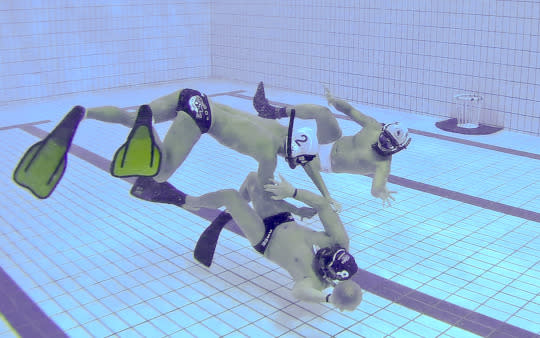Singapore underwater rugby team aims to raise sport's profile
Video by Jeremy Ho, Text and Photos by Stefanus Ian

The FATUWR players training at Queenstown Swimming Complex’s 4.5-metre deep pool ahead of the 2016 Pan Pacific Cup Underwater Rugby.
The two six-a-side teams tussle underwater, tugging at each other and fighting for possession of a ball which they try to drop into a basket at the bottom of the swimming pool. All while holding their breath. Every 10 seconds or so, players re-surface, then dive back into the action.
The relatively unknown sport is played in a deep swimming pool. The objective of the game is to put a ball, which is filled with saltwater so that it will sink in the pool, into the opponent’s goal basket. Players are allowed to grab other players in order to steal possession of the ball as long as contact is made below the neck and above the ankle. Indecent touches are also not allowed.
Underwater rugby is fascinating to watch, and Singapore even has a team which represents the country at overseas tournaments.
After creating a splash at the 2015 Pan Pacific Cup Underwater Rugby by coming in third, Singapore's only underwater rugby club FATUWR is aiming for another podium finish at this year’s edition.
FATUWR, which stands for First Asian Team Underwater Rugby, were just over eight months old when they stunned more experienced teams last year at the tournament in Brisbane. On Thursday (May 26), the team is flying back to Australia with the hopes of doing better.
“We are hoping to go far, or at least maintain our status from last year,” Marcus Chua, vice president of FATUWR, told Yahoo Singapore.
“We hope to do well there and we’ve been training hard,” added the 28-year-old, who is also the lead coach for the team.
Raising awareness and retaining players
Despite being formed just less than two years ago, FATUWR has been making waves in the regional underwater rugby scene. Apart from beating more experienced teams at the 2015 Pan Pacific Cup, the club has also actively helped to grow the sport in the region.
“We’ve helped set up three teams in China: Guangzhou, Shanghai and Chengdu... we’ve also reached out to Hong Kong, so the sport will grow in this region, bearing in mind that the sport is still in its infancy stages in this region,” said Stanley Ng, 30, president of FATUWR.
“The sport is still considered young, most people have never heard about underwater rugby,” Ng added.

The FATUWR players training at Queenstown Swimming Complex’s 4.5-metre deep pool.
The club has been trying to raise awareness about the sport by promoting it at the Asia Dive Expo in Singapore and inviting people to join them for a session at Queenstown swimming complex.
But apart from the lack of awareness, Chua said the biggest problem from the club is retaining players. Chua says it is difficult seeing some players that he coached give up on the sport after a few months.
“They gave up in the end, and I just felt like we’ve been working on this for three months, four months and they never came back,” Chua sighed.
“Underwater sports, there’s a certain beauty (to it) but we all know that not everyone is comfortable underwater.”

The FATUWR players training at Queenstown Swimming Complex’s 4.5-metre deep pool ahead of the 2016 Pan Pacific Cup Underwater Rugby. The objective of the game is to put the ball, which is filled with salt water, into the opponent’s basket.
Breaking the psychological barrier
There is a certain psychological barrier that newcomers to the sport have to break through, especially when it comes to not breathing while being underwater.
“Some people akin it to the feeling of dying, some people call it that want to breathe, the impulse to breathe,” Chua explained.
“For some people it’s violent, for some people it’s mild and that’s always the first step. So how we negotiate around this impulse to breathe is really what determines the entire experience,” he added.
But once they get past that stage, Chua said the sport gives players a certain empowerment in terms of progression – and it’s not just about learning how to swim better.
“It’s about being underwater 4.5 metres deep doing movements you thought you could not do,” Chua said.
“(While) underwater, when you hold your breath, there’s a certain moment of zen when your mind and your breath comes to a still and if you ask me, that is what I come back for.”

